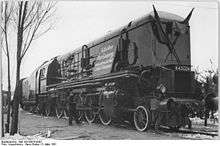DRG Class 45
| DRG Class 45 | |
|---|---|
 | |
| Number(s) | 45 001 – 45 028 |
| Quantity | 28 |
| Manufacturer | Henschel |
| Year(s) of manufacture | 1936–1937 |
| Retired | 1946–1968 |
| Wheel arrangement | 2-10-2 |
| Axle arrangement | 1′E1′ h3 |
| Type | G 57.18 (also G 57.20) |
| Gauge | 1,435 mm (4 ft 8 1⁄2 in) |
| Length over buffers | 25.645 m (84 ft 1 3⁄4 in) |
| Service weight | 125.5 t (123.5 long tons; 138.3 short tons) |
| Adhesive weight | 97.2 t (95.7 long tons; 107.1 short tons) |
| Axle load | 19.7 t (19.4 long tons; 21.7 short tons) |
| Top speed | 90 km/h (56 mph) |
| Indicated Power | 2,059 kW (2,761 hp) 2,221 kW (2,978 hp) (45 003) |
| Driving wheel diameter | 1.600 m (5 ft 3 in) |
| Leading wheel diameter | 1.000 m (3 ft 3 3⁄8 in) |
| Trailing wheel diameter | 1.250 m (4 ft 1 1⁄4 in) |
| No. of cylinders | 3 |
| Cylinder bore | 520 mm (20 1⁄2 in) |
| Piston stroke | 720 mm (28 3⁄8 in) |
| Boiler Overpressure | 16 bar (1.6 MPa; 230 psi) |
| Grate area | 4.47 m2 (48.1 sq ft) |
| Superheater area | 120 m2 (1,300 sq ft) |
| Evaporative heating area | 269.02 m2 (2,895.7 sq ft) |
| Tender | 2'3 T 38 2'3 T 29 Stoker |
| Water capacity | 29,000 or 38,000 l (6,400 or 8,400 imp gal; 7,700 or 10,000 US gal) |
German Class 45 steam locomotives were standard locomotives (Einheitslokomotiven) designed by the Deutsche Reichsbahn for hauling goods trains.
History
The Class 45 engines were the most powerful steam locomotives ever operated in Germany. They were built between 1936 and 1937 by the firm of Henschel. After the first two engines entered service, a further 26 units were delivered in 1940. However, the third order for another 103 machines was cancelled in 1941, because the outbreak of the Second World War favoured the construction of simpler wartime locomotives, the so-called Kriegslokomotiven. The Class 45s were given the operating numbers 45 001 – 45 028.
After the war, boiler damage appeared very quickly that made a reduction of the boiler overpressure to 16 bar necessary. From 1950 therefore several Deutsche Bundesbahn machines were equipped with an outer firebox with a combustion chamber and a mechanical underfeed stoker (Rostbeschicker). The engines with operating numbers 45 010, 45 016, 45 019, 45 021 and 45 023 were provided with welded boilers and underfeed stoker equipment.
In East Germany, the Deutsche Reichsbahn's sole example, 45 024, was rebuilt into high pressure variant and renumbered H 45 024. It proved to be a failure and was retired in 1959. Parts of this locomotive (outside cylinders, trailing wheels and the rear section of the locomotive frame) were used in building engine no. 18 201.


In 1968 the Deutsche Bundesbahn only had three examples left, which were used as braking and experimental engines by the Bundesbahn Central Office in Munich and Minden. They were no. 45 023, which was stabled in Munich, and nos. 45 010 and 45 019, which were stationed at Minden. On the evening of 17 October 2005 a fire destroyed the locomotive shed of the Nuremberg Transport Museum in Nuremberg, as a result of which the last preserved example of this class, the 45 010, was badly damaged. It is planned to restore it.
This class was initially a faulty design, similar to the DRB Class 06, because of its poor boiler. Following replacement of the boiler and the introduction of mechanical stoking the true qualities of this locomotive became clear. As well as being used as braking locomotives for the Bundesbahn Central Office, in their final years numbers 45 019 and 45 010 were used time and again for those heavy goods train duties that the Class 44 locomotives had difficulties with.
The vehicles were coupled with 2'3 T 38 tenders. Those with underfeed stokers had 2'3 T 29 Stoker tenders.
| Year | Quantity in service at start of year |
Quantity withdrawn |
Locomotive numbers | Notes |
|---|---|---|---|---|
| 1946 | 27 | 1 | 45 002 | |
| 1953 | 26 | 12 | 45 001, 005–007, 013, 015, 017, 018, 025–028 | |
| 1955 | 14 | 2 | 45 004, 011 | |
| 1957 | 12 | 6 | 45 003, 008, 009, 014, 021, 022 | 021 reboilered |
| 1958 | 6 | 1 | 45 012 | later reinstated |
| 1959 | 5 or 6 | 1 | 45 020 | |
| 1961 | 5 | 1 | 45 012 | |
| 1964 | 4 | 1 | 45 016 | reboilered |
| 1968 | 3 | 2 | 045 019-7, 023-9 | reboilered |
| 1969 | 1 | 1 | 045 010-6 | reboilered; preserved |
See also
Literature
- Seiler, B.; Ebel, Jürgen U. (2006). Die Baureihe 45 (in German). Freiburg: EK-Verlag. ISBN 978-3-88255-151-8.